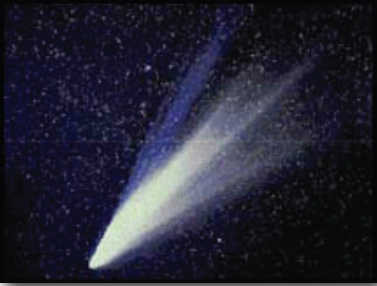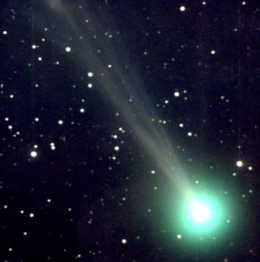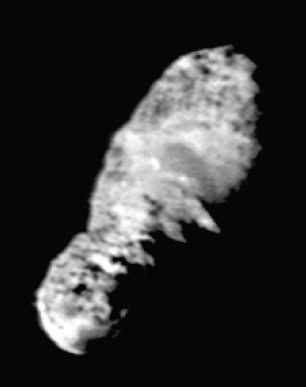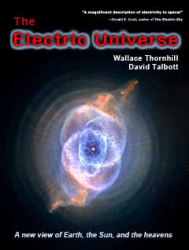|
|
Excerpts From The Electric Universe
Electric Comets Part 2
The following is one of a series of excerpts from The Electric Universe,
copyright © 2002, 2007 Wallace Thornhill and David Talbott and published by
Mikamar Publishing. Reproduced with the kind permission of the authors and publisher.
Presented by Dave Smith
|
|
|
|
January 24, 2010
|
|
|
This week we present the orthodox "dirty snowball" model and contrast
it with the plasma discharge (electric comet) model. In presenting these in dot-point form it
is easy to see that the plasma discharge model explains and even predicts the observations much more accurately
than does the currently accepted model of comets.
Chapter 4 - Electric Comets (Cont'd.)
Page 91:
Dirty Snowball Model
-
The solar system formed billions of years ago by gravitational
accretion from a primordial solar nebula, which formed a disk of interstellar
dust and ices.
-
Gentle or 'sticky' collisions agglomerated the dust and ices into
larger bodies (planetesimals).
-
In ways not understood, the planets then grew by 'runaway accretion'
of planetesimals.
-
The leftover dust and gas was dispersed by a presumed energetic
phase of the early Sun.
-
The planets found themselves in remarkably circular orbits.
-
Comets are supposed to be composed of undifferentiated 'protoplanetary
debris' - dust and ices left over from the formation of the
outer planets where temperatures in the disk were low. On this
model, comets are a mixture of frozen water, carbon monoxide,
methane, ammonia and about an equal amount of dust.
-
Comets are injected into the inner and outer solar system from a
vast unseen reservoir called the 'Oort cloud.' Those in the inner solar
[p 92]
system contributed to an early episode of heavy bombardment of the
inner planets. Those flung outward were lost or somehow 'stored' in
the Oort cloud, to be occasionally disturbed back into the inner solar
system by a passing star.
Page 92:
-
Comets in the Oort cloud are exposed to radiation, or space
weathering, for billions of years. Only the upper surface layers are
affected.
-
As the comet swings through the inner solar system, radiant heat
from the Sun sublimates ices from the nucleus. The gases and accompanying
dust expand around the nucleus to generate the coma
and are swept back by the solar wind to form the comet's ion and
dust tails.
-
Repeated passages around the Sun vaporize surface ice and
leave a 'rind' of dust.
-
Pockets of gas form where solar heat penetrates the surface of
the blackened, shallow crust. Energetic jets form where the gas
breaks through the surface.
-
The comet coma is generated by the collision of gases from the
comet with the solar wind. Comet comas are amongst the largest objects
in the solar system.
-
Strange accelerations of comets are due to ‘rocket action’ of the
jets from the nucleus.
-
Comets disintegrate because pockets of gas form inside the nucleus,
solar heating increases the pressure, and the fragile nucleus
fractures.
Plasma Discharge Model
-
The plasma discharge model of comets is inseparable from the
electric Sun model. This model envisions the Sun forming in a galactic
electromagnetic 'Z-pinch' at some unknown time in the past. A Zpinch
is the most effective long-range scavenger of interstellar dust
to form stars. Laboratory experiments show that a number of 'stars'
are formed simultaneously along the axis of a Z-pinch. Once the
'pinch' subsides the stars 'scatter like buckshot.'
-
Planets are formed in several separate episodes of 'electrical
parturition' of stars and gas giants. Stellar ‘accretion disks’ and
planetary rings are in fact 'expulsion disks.' This model accounts for
'hot Jupiters' found closely orbiting their parent star. Stellar ejection
of 'blobs' of matter is observed in deep space. The rings of our gas
giants are evidence of past electrical expulsions.
-
Subsequent electromagnetic capture and circularization of
planetary orbits is accompanied by interplanetary plasma arcing.
-
Moons, comets, asteroids, meteorites and planetary rings are
debris that has been electrically expelled or torn from a planetary
body. Their composition will vary depending on the parent body.
Page 93:
-
Comets were electrically 'machined' in their
natal event. Blackened and pitted comet surfaces
reflect their origin in an intense plasma discharge.
Comets can be considered 'asteroids on eccentric
orbits.'
-
Comets follow elongated paths within a weak
radial electric field centered on the Sun. All solar
system bodies, including comets, are negatively
charged with respect to the Sun. Comets spend
most of their time remote from the Sun, and while
there, they adopt a voltage in keeping with that
environment.
-
As a comet accelerates toward the Sun, it encounters
a steadily rising plasma density and voltage.
The strength of the electric field within the
comet’s plasma sheath thus steadily increases until the plasma discharge
suddenly switches from dark mode to glow mode (see information
panel p. 96).
-
A glow discharge produces the visible coma around the nucleus.
-
Eventually, increasing electrical stress on the nucleus causes the
discharge to switch suddenly to 'arc' mode. Cathode arcs begin to
dance over the comet nucleus, giving it a star-like appearance
through a telescope.
-
Rock is electrically 'sputtered,' particle by particle, from the
surface and accelerated vertically into space in the form of wellcollimated
jets, following the natural curved trajectories of particles
from a 'plasma gun.'
-
The ejected ionized material is guided electromagnetically into
a coherent comet tail. The ion tails of comets reveal well-defined
Birkeland current filaments extending up to tens of millions of km
without dissipating in the vacuum of space—a 'violation' of gas
behavior in a vacuum. (Heated gas in a vacuum will normally
disperse explosively.)
|

Comet West in its most dramatic
display in March, 1976. The colossal
size of cometary displays cannot be
explained by the passage of a tiny
body through an extremely tenuous
solar 'wind' and relying on solar
heating alone to remove material from
the nucleus.
Credit: Observatoire de Haute,
Provence, France
[Click to enlarge]
|
-
Puzzling comet behavior becomes a unified and predictable
result of plasma discharge effects. The cathode-arc discharges to the
nucleus produce the characteristic forms of electric discharge
machining (EDM) of the comet surface, with sharply scalloped
craters, terraces and mesas.
-
Cathode arcs tend to jump from one spot to another, which
explains the sudden switching off and on of comet jets.
-
The wandering cathode arcs, seen as enigmatic white spots in
close-up images of the comet nucleus, erode the surface and burn it
black, which accounts for the surprising discovery that comet nuclei
are the darkest bodies in the solar system, "blacker than copier
toner."
Page 94: INFORMATION PANEL [ Permalink ]
'Deep Impact' - Where is the Water?
|

Deep Impact saw absolutely no evidence for
any ice on the surface of comet Tempel 1. At 56 °C
(133 °F) on the sunlit side it was too hot for ices.
However, it was reported that there's plenty of ice
visible in Tempel 1's coma.
On viewing comet comas spectroscopically and
observing the hydroxyl radical (OH), astronomers
simply assume it to be a residue of water ice (H2O)
broken down by the ultraviolet light of the Sun
(photolysis). This assumption requires a reaction
rate due to solar UV radiation beyond anything that
can be demonstrated experimentally.
A report in Nature more than 25 years ago cast
doubt on this mechanism. As
Comet Tago-Sato-Kosaka
moved away from the Sun,
OH production fell twice as
fast as that of H, and the ratio
of OH:H production was
lower than expected if H2O
was dominant. The report
concludes, “cometary scientists
need to consider more
carefully whether H2O-ice
really does constitute a major
fraction of comet nuclei.”
The mystery of ‘missing
water’ is resolved electrically
in the transaction between
a negatively charged comet and the Sun. In
this model, electrical discharges strip negative oxygen
ions from rocky minerals on the nucleus and
accelerate the particles away from the comet in energetic
jets. The negative ions then combine with
protons from the solar wind to form the observed
OH radical, neutral H2O and H2O+.
Alfvén and Gustav Arrhenius note, “The assumption
of ices as important bonding materials in
cometary nuclei rests in almost all cases on indirect
evidence, specifically the observation of atomic hydrogen
and hydroxyl radical in a vast cloud surrounding
the comet, in some cases accompanied by
observation of H20+ or neutral water molecules.” *
The abundance of silicates on comet nuclei,
confirmed by infrared spectrometry, led the authors
to cite experiments by Arrhenius and Andersen. By
irradiating the common mineral, calcium aluminosilicate
(anorthite), with protons in the 10 kilovolt
range, the experiments “resulted in a substantial
(~10 percent) yield of hydroxyl ion and also hydroxyl
ion complexes [such as CaOH.]”
A good reason for the experiments was already
in hand. Observations on the lunar surface
reported by Hapke et al., and independently by Epstein
and Taylor had “already demonstrated that
such proton-assisted abstraction of oxygen (preferentially
016) from silicates is
an active process in space,
resulting in a flux of OH and
related species.”
The authors note in addition
that this removal of oxygen
from particles of dust in the
cometary coma could be
much more efficient than on
a solid surface with limited
exposure to available protons:
“The production of
hydroxyl radicals and ions
would in this case not be
rate-limited by surface saturation
to the same extent as
on the Moon.”
The authors conclude: “These observations,
although not negating the possible occurrence of
water ice in cometary nuclei, point also to refractory
sources of the actually observed hydrogen and
hydroxyl.” Additionally, they note, solar protons as
well as the products of their reaction with silicate
oxygen would interact with any solid carbon and
nitrogen compounds characteristic of carbonaceous
chondrites to yield the volatile carbon and nitrogen
radicals observed in comet comas.
*H Alfvén and Gustav Arrhenius, Evolution of
the Solar System, NASA SP-345, 1976, p. 235.
|
Page 95:
-
Ices are not buried beneath a dirty crust. The presence of
water is inferred from the hydroxyl molecule [OH] in the comet’s
coma. New evidence shows that the main source of OH is the
combination of hydrogen from the solar wind with negative
oxygen ions, sputtered from cometary surface minerals (see
information panel on facing page). 97
-
Electrical heating of the surface of the comet nucleus and the
lack of cooling effect from non-existent sublimating ices accounts
for the higher than expected temperatures of the comet
nucleus.
|

Comet Borrelly's nucleus, as recorded by
Deep Space 1 on September 22, 2001.
Borrelly's 'icy heart' exhibits no trace of
water ice or any water-bearing minerals.
Moreover, the nucleus is actually quite
hot — ranging from 300 to 345 Kelvin
(80° to 160° F).
Credit: NASA/JPL.
[Click to enlarge]
|
-
The diameter of the visible coma will often reach several
millions of kilometers. It is the electric force, not gravity, that
enables the cometary nucleus to hold the coma in place as it
careens around the Sun.
-
It is the electric force that accelerates the ion tails of a comet
as it sweeps around the Sun.
-
The coma temperature (as hot as the solar corona) and the
emission of X-rays are both explained as plasma discharge
phenomena.
-
Comet nuclei behave like an electret (similar to a capacitor, but
able to store electric charge for a much longer time). As such the
nucleus can explode when the internal electrical stresses, caused by
the discharge activity at the surface, results in an internal discharge.
The many examples of an exploding comet are thus analogous to
an exploding capacitor, in which the insulating dielectric suffers a
spark-over and fails. The current through the dielectric causes
sudden internal heating, which may explosively fragment the
capacitor.
|
|
References:
97 L. Kristoferson, K. Fredga, "Laboratory Simulation of Cometary Erosion by Space
Plasma," Astrophysics & Space Science 50 (1977) pp. 105-123. "the production of
OH in space from 'dry,' water free matter is possible by means of molecular sputtering
from several cosmically abundant types of materials." However, the production rate is
too low without electrical sputtering.
|
|
|
|
|
Permalink to this article.
Email this article to a friend
Public comment may be made on this article on the
Thunderbolts Forum/Thunderblogs (free membership required).
To read more from Wal Thornhill please visit:
holoscience.com
|
|
|
|
|
|
|
|
|
YouTube video, first glimpses of Episode Two in the "Symbols of an Alien Sky"
series.
|
|
|
|
|
|
|
Three ebooks in the Universe Electric series are
now available. Consistently
praised for easily understandable text and exquisite graphics.
|
|
|
|
|
|
|
|










